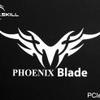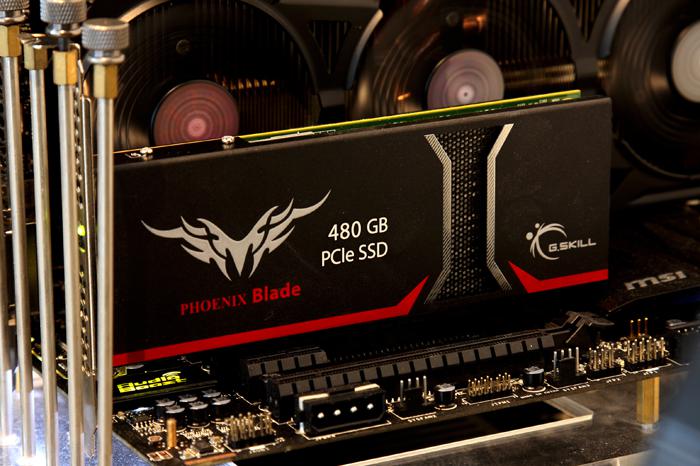Final Words & Conclusion
Final Words & Conclusion
GSKILL is killing it with the Phoenix Blade, it is tremendously fast (with a few exceptions in benchmarks here and there). There are two concerns though, PCI Express based storage can be difficult in the sense that these products can react differently on the wide diversity of motherboards and processors. Also, in one hand it is a product that everybody likes then in the other we need to factor in the price. That thesis will not be any different with this Phoenix Blade series. The good things however is that NAND flash prices have plummeted ever since the last year or so, and where two years ago you had to pay 2 to 3 grand for a product like this, now you can purchase it for $699.99 (USD). The reality is that a 480 GB SSD can be purchased for say 200 to 300 USD. The performance differential however is huge. The most direct competitor for the Phoenix Blade would be the RevoDrive 350 from OCZ, that product is a hundred bucks more expensive. Overall the Phoenix Blade will be a notch faster, but OCZ can deal a better card after-sales wise in terms of warranty and support. Overall we of course are impressed with the Phoenix Blade, the usage of 2 to 4 LSI SandForce SSD controllers (depending on the model you purchase) and a RAID chip to make all this sweet perf happen, but sure price per GB wise the real conundrum is that this product a bit expensive.
Performance
The Phoenix Blade (480 GB) performance is close to advertised, it can reach near 1,500 to 2,00 MB/sec reads and yeah it surely does reach similar writes. This however always goes for selected benchmarks with bigger sequential and linear writes. We have seen oddities on some benchmarks and raving perf on others. Once you pass 64/128 KB files sizes the performance jumps up hard and fast easily passing 1,500 MB/sec easily. So the PCI Express storage unit shines at large sequential writes. IOPs performance was very good as well. Unfortunately our trace test PCMark Vantage 64-bit was showing massive issues with the Phoenix Blade, just like RevoDrives we tested this suite always has issues with RAID solutions somehow. It was such a weird anomaly that we deiced to simple leave out the results as it has to be isolated to our test system.
Overall SSD Usage
As stated we very much enjoy the grand overall performance of this SSD series, so when you copy a fast amount of compressed data, then the SSD will perform seriously fast in performance. Make no mistake, replacing a HDD with an SSD in your desktop PC or laptop eliminates the random access lag of the HDD head, it is no longer mechanical. That combined with the performance a PCIe solution offers these days is simply a massive difference and probably the best upgrade you can make for your computer anno 2014 if you are pursuing enthusiast class performance.
Price, HDD VS SSD
This is my standard paragraph on how we feel about Nand Flash storage solutions. This paragraph is about SSDs in general, not specific to the Phoenix Blade. First a generic rule that I always apply; you should probably stop looking at the Solid State Disk technology as if it were a traditional HDD. We'll all be old and grey before the two reach the same prices or top the multiple TB volume storage the HDD offers for less money. Comparing an SSD with an HDD is making a comparison in-between an integrated IGP or a dedicated graphics card, that last one will cost you a heck of a lot more yet you gain incredible overall performance. It is the very same with an SSD, use it as boot drive on Windows and applications and you instantly have removed a huge bottleneck, namely load and access times. It is a difference in-between night and day (in a proper system). For massive storage like movies, MP3 files and bulky data you do not access on a regular basis, sure that's where the HDD remains the winner as a cheaper storage solution. Guru3D's rule of thumb; the magic simply is finding a good combination in-between the two and balance things out. Use a nice 240 GB SSD for your operating system and applications, and park these movies and MP3 files onto a separate TB HDD. That's where the magic happens. I kid you not, all my test systems and work systems run on SSDs, not once have I considered going back to HDDs. The benefits of a good SSD are simply grand. But that doesn't mean I do not understand the budget and cost dilemma that many of you are facing though.
Pricing
You may expect the following prices for the 480 GB model as tested today, 480 GB for 699 USD which is 1.46 USD per GB. These are street prices. You'll receive a three year carry-in warranty with this drive. Albeit steep, keep in mind that in 2011 a similar 480 GB product did cost 2,000 USD!
Concluding
This year we'll see 10 Gbps interfaces like the M2 port take off, bringing performance close to say 700 - 800 MB/sec on a small SSD that you infect inject into your motherboard. The next step is a PCI Express based add-in card in RAID and multiple NAND Flash controllers. The Phoenix Blade is a first from GSKILL and truth be told, it is a mighty impressive performing product. BTW small tip, keep in mind that the storage unit is bootable, but during Windows installation you will need to load up the RAID controller driver in order to access and drop the OS in it. Alternatively you could also drop an OS image clone onto the driver of course. So yeah, the Phoenix Blade 480 GB offers pure unadulterated performance. Few, very few can come close to what GSKILL offers here, on the consumer market that party would be OCZ with their smexy RevoDrive 350. Regardless of what your preference might be, The Phoenix Blade 480 GB could easily be on my personal shortlist of products that I prefer, but we do understand the complication of its pricing level in relation to big SSDs. One last quick note to GSKILL, next time, a black PCB okay?
Recommended Downloads


